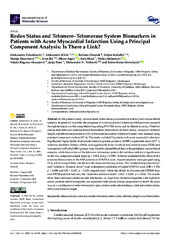Приказ основних података о документу
Redox Status and Telomere–Telomerase System Biomarkers in Patients with Acute Myocardial Infarction Using a Principal Component Analysis: Is There a Link?
| dc.creator | Vukašinović, Aleksandra | |
| dc.creator | Klisic, Aleksandra | |
| dc.creator | Ostanek, Barbara | |
| dc.creator | Kafedžić, Srđan | |
| dc.creator | Zdravković, Marija | |
| dc.creator | Ilić, Ivan | |
| dc.creator | Sopić, Miron | |
| dc.creator | Hinić, Saša | |
| dc.creator | Stefanović, Milica | |
| dc.creator | Bogavac-Stanojević, Nataša | |
| dc.creator | Marc, Janja | |
| dc.creator | Nešković, Aleksandar | |
| dc.creator | Kotur-Stevuljević, Jelena | |
| dc.date.accessioned | 2023-10-10T07:58:48Z | |
| dc.date.available | 2023-10-10T07:58:48Z | |
| dc.date.issued | 2023 | |
| dc.identifier.issn | 1661-6596 | |
| dc.identifier.uri | https://farfar.pharmacy.bg.ac.rs/handle/123456789/5078 | |
| dc.description.abstract | In the present study, we examined redox status parameters in arterial and venous blood samples, its potential to predict the prognosis of acute myocardial infarction (AMI) patients assessed through its impact on the comprehensive grading SYNTAX score, and its clinical accuracy. Potential connections between common blood biomarkers, biomarkers of redox status, leukocyte telomere length, and telomerase enzyme activity in the acute myocardial infarction burden were assessed using principal component analysis (PCA). This study included 92 patients with acute myocardial infarction. Significantly higher levels of advanced oxidation protein products (AOPP), superoxide anion (O2•−), ischemia-modified albumin (IMA), and significantly lower levels of total oxidant status (TOS) and total protein sulfhydryl (SH-) groups were found in arterial blood than in the peripheral venous blood samples, while biomarkers of the telomere–telomerase system did not show statistical significance in the two compared sample types (p = 0.834 and p = 0.419). To better understand the effect of the examined biomarkers in the AMI patients on SYNTAX score, those biomarkers were grouped using PCA, which merged them into the four the most contributing factors. The “cholesterol–protein factor” and “oxidative–telomere factor” were independent predictors of higher SYNTAX score (OR = 0.338, p = 0.008 and OR = 0.427, p = 0.035, respectively), while the ability to discriminate STEMI from non-STEMI patients had only the “oxidative–telomere factor” (AUC = 0.860, p = 0.008). The results show that traditional cardiovascular risk factors, i.e., high total cholesterol together with high total serum proteins and haemoglobin, are associated with severe disease progression in much the same way as a combination of redox biomarkers (pro-oxidant-antioxidant balance, total antioxidant status, IMA) and telomere length. | |
| dc.publisher | MDPI | |
| dc.relation | info:eu-repo/grantAgreement/MESTD/inst-2020/200161/RS// | |
| dc.rights | openAccess | |
| dc.rights.uri | https://creativecommons.org/licenses/by/4.0/ | |
| dc.source | International Journal of Molecular Sciences | |
| dc.subject | telomere length | |
| dc.subject | acute myocardial infarction | |
| dc.subject | atherosclerosis | |
| dc.subject | novel biomarkers | |
| dc.subject | redox status | |
| dc.title | Redox Status and Telomere–Telomerase System Biomarkers in Patients with Acute Myocardial Infarction Using a Principal Component Analysis: Is There a Link? | |
| dc.type | article | |
| dc.rights.license | BY | |
| dc.citation.volume | 24 | |
| dc.citation.issue | 18 | |
| dc.citation.rank | M21~ | |
| dc.identifier.doi | 10.3390/ijms241814308 | |
| dc.identifier.pmid | 37762611 | |
| dc.identifier.scopus | 2-s2.0-85172798150 | |
| dc.identifier.fulltext | http://farfar.pharmacy.bg.ac.rs/bitstream/id/14044/Redox_Status_and_pub_2023.pdf | |
| dc.type.version | publishedVersion |

